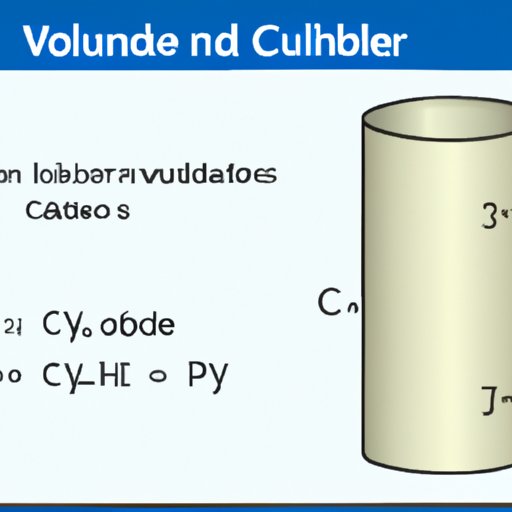
Introduction
Understanding how to calculate the volume of a cylinder is a valuable skill for a variety of professions, from engineering to cooking. The volume of a cylinder is the amount of space it encompasses, and it’s important to know how to calculate it accurately. This article aims to provide a comprehensive guide to calculating cylinder volume, from formulating the formula to practical applications.
Formulating the Formula
The formula for calculating the volume of a cylinder is V = πr²h, where V is volume, r is radius, h is height, and π is a mathematical constant (approximately equal to 3.14). Breaking down each variable is crucial to understanding the formula. The radius is the distance between the center of the cylinder and its perimeter and is usually represented by the letter “r.” The height is the distance between the two circular bases and is represented by the letter “h.”
Step-by-Step Guide for Calculating Cylinder Volume
To calculate the cylinder volume, follow these steps:
- Determine the radius of the cylinder (r).
- Determine the height of the cylinder (h).
- Square the radius (r²).
- Multiply the squared radius (r²) by π (3.14).
- Multiply the result by the height (h).
Additionally, there are different ways to measure a cylinder’s dimensions, including the diameter and circumference, which all have their respective formulas. It’s important to avoid common mistakes such as forgetting to square the radius or multiplying by the wrong value of pi.
Beginner’s Guide to Cylinder Volume Calculation
For those new to math or unfamiliar with formulas, calculating cylinder volume can seem daunting. However, breaking down the steps and utilizing examples can help simplify the process. Calculating cylinder volume is useful in real-world scenarios, such as determining how much liquid a container can hold or how much soil a planter box can fit.
Practical Applications of Cylinder Volume Calculation
Calculating cylinder volume has a range of practical applications in various industries, including engineering, construction, cooking, and more. Engineers need to calculate cylinder volume when designing structures or constructing cylinders such as fuel tanks. Cooks use cylinder volume to measure ingredients and determine cooking times. Understanding how to calculate cylinder volume is essential in these fields and many others.
Tips, Tricks, and Examples for Calculating Cylinder Volume
There are several helpful tips and tricks to simplify the process of calculating cylinder volume. One method is called the water displacement method, which involves filling the cylinder with water and measuring the amount displaced. Another is to use the formula for the area of a circle to calculate the radius. Breakdowns and additional examples can further help understand the importance of cylinder volume calculation.
Techniques for Students and Professionals
For students and professionals alike, simple techniques and tools exist to aid in calculating cylinder volume. Websites such as Mathway or Symbolab can provide quick and easy solutions, while mobile apps like Photomath allow users to input a picture of the problem to generate a step-by-step solution.
Conclusion
Calculating cylinder volume is a crucial skill applicable in many fields. Understanding the formula and the variables involved can aid in solving various problems and is a valuable asset in any profession. Practicing the steps and utilizing resources available can lead to a better understanding of cylinder volume calculation and its importance in real-world applications.




